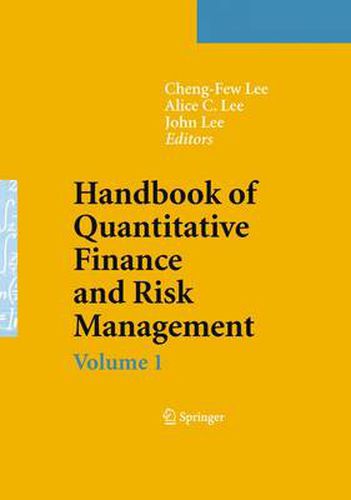Readings Newsletter
Become a Readings Member to make your shopping experience even easier.
Sign in or sign up for free!
You’re not far away from qualifying for FREE standard shipping within Australia
You’ve qualified for FREE standard shipping within Australia
The cart is loading…






Quantitative finance is a combination of economics, accounting, statistics, econometrics, mathematics, stochastic process, and computer science and technology. Increasingly, the tools of financial analysis are being applied to assess, monitor, and mitigate risk, especially in the context of globalization, market volatility, and economic crisis. This two-volume handbook, comprised of over 100 chapters, is the most comprehensive resource in the field to date, integrating the most current theory, methodology, policy, and practical applications. Showcasing contributions from an international array of experts, the Handbook of Quantitative Finance and Risk Management is unparalleled in the breadth and depth of its coverage. Volume 1 presents an overview of quantitative finance and risk management research, covering the essential theories, policies, and empirical methodologies used in the field. Chapters provide in-depth discussion of portfolio theory and investment analysis. Volume 2 covers options and option pricing theory and risk management. Volume 3 presents a wide variety of models and analytical tools. Throughout, the handbook offers illustrative case examples, worked equations, and extensive references; additional features include chapter abstracts, keywords, and author and subject indices. From arbitrage to yield spreads, the Handbook of Quantitative Finance and Risk Management will serve as an essential resource for academics, educators, students, policymakers, and practitioners.
$9.00 standard shipping within Australia
FREE standard shipping within Australia for orders over $100.00
Express & International shipping calculated at checkout
Quantitative finance is a combination of economics, accounting, statistics, econometrics, mathematics, stochastic process, and computer science and technology. Increasingly, the tools of financial analysis are being applied to assess, monitor, and mitigate risk, especially in the context of globalization, market volatility, and economic crisis. This two-volume handbook, comprised of over 100 chapters, is the most comprehensive resource in the field to date, integrating the most current theory, methodology, policy, and practical applications. Showcasing contributions from an international array of experts, the Handbook of Quantitative Finance and Risk Management is unparalleled in the breadth and depth of its coverage. Volume 1 presents an overview of quantitative finance and risk management research, covering the essential theories, policies, and empirical methodologies used in the field. Chapters provide in-depth discussion of portfolio theory and investment analysis. Volume 2 covers options and option pricing theory and risk management. Volume 3 presents a wide variety of models and analytical tools. Throughout, the handbook offers illustrative case examples, worked equations, and extensive references; additional features include chapter abstracts, keywords, and author and subject indices. From arbitrage to yield spreads, the Handbook of Quantitative Finance and Risk Management will serve as an essential resource for academics, educators, students, policymakers, and practitioners.